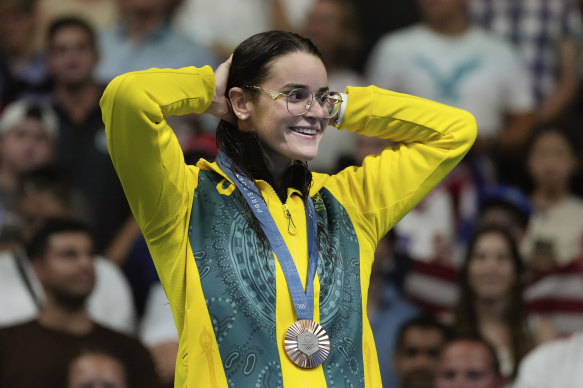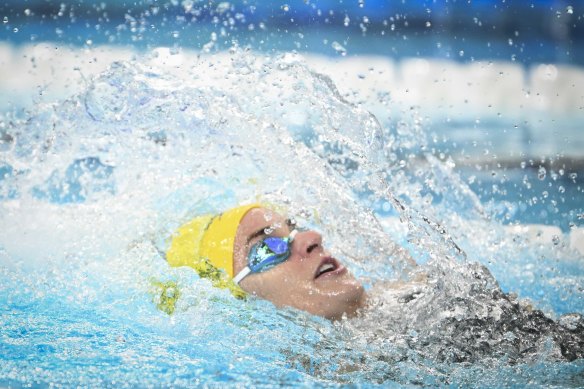This was published 8 months ago
McKeown just missed bronze – until a ‘history-changing’ video review
By Chip Le Grand and Dan Walsh
It is only fitting that in an event as technical as the individual medley, the rule that governs how swimmers glide to the wall on their backs at the end of the backstroke leg, flip onto their tummies and start their breaststroke leg, is as clear as the motivation for anyone to swim four different ways to cover 200m.
Yet, it is this regulatory minefield, planted at the midpoint of every IM race, which routinely causes some of the best swimmers in the world to come a cropper.
Kaylee McKeown knows this from bitter experience, when she was denied a place in the 200IM final at last year’s world championships after a pool deck official decided that in the second turn of her race, from her beloved backstroke to breaststroke, she rolled her body past an imagined meridian line that separates your back from your front.
But as Mark Knopfler sang, sometimes you’re the bug and sometimes you’re the windscreen. At these Games, it was America’s Alex Walsh who on Saturday night in Paris had a joyous Olympic moment squished by this most fickle rule of swimming.
With the third-placed Walsh disqualified, McKeown found herself with an unexpected bronze medal around her neck. She had nearly walked off the pool deck before she was told about the change in finishing order. It continues her extraordinary run of exiting with hardware of some colour every time she dives into La Défense Arena pool.

Kaylee McKeown on the podium for the women’s 200m individual medley after receiving her surprise bronze medal.Credit: AP
The judges had barely confirmed McKeown had taken bronze behind American silver medallist Kate Douglass and Canadian star Summer McIntosh, when McKeown was hurrying to join her teammates back in the marshalling room for another go round in the mixed medley relay. Another race and another medal made it four for the meet.
McIntosh set a new Olympic record of 2:06.56 to win the individual medley. McKeown’s time of 2:08.08 was about a second and a half off her best.
McKeown’s good fortune follows a week of spectacular swimming by the 23-year-old backstroke queen. A night earlier, she completed an extraordinary, double/double by winning the 100m and 200m in Paris to add to her two gold medals from the same events in Tokyo.
No man or woman has previously swept all backstroke events across two Olympics.
McKeown is likely to add to her personal medal tally on Sunday night when she swims the backstroke leg in the women’s medley relay.
This was also a cruel outcome for Walsh, a 23-year-old University of Virginia student who won a silver medal in Tokyo in the same event.
Before he saw the dreaded DQ flash up against her name, Walsh thought she had written some history of her own. Instead, she goes home with the video footage of what she did wrong on her turn seared into her memory. This was her only event at these Games.

Kaylee McKeown during the backstroke leg of the individual medley.Credit: Eddie Jim.
Under the rules of the sport, medley swimmers have to remain on their backs until they touch the wall at the end of their backstroke and turn into their breaststroke leg. There is some ambiguity, however, as swimmers are allowed to start rotating their bodies before they touch, so long as they don’t end up more on their front than their back by the time their fingertips touch the wall.
There is a delicate artistry in this. Rotate too little and you lose valuable time on your turn. Rotate too much and you risk a DQ.
The mistake Walsh made, at least in the eyes of race officials, was to rotate too far before she touched.
McKeown was judged to have made the same mistake at the 2023 world championships in Fukuoka, Japan, when she was DQ’d in a semi-final and stripped of her chance at a medal in the final. She was still frustrated about it the morning after the race.
“I didn’t see my turn last night, but when I saw it this morning I thought it was completely unfair … shit happens,” McKeown said.
“We have footage and other angles that say otherwise to what the officials saw. You’ve got to go with what they’re saying. That’s the rules and I broke the rules, apparently. I can’t do much about that.
“Unfortunately, some people get dealt a bad hand. It’s a matter of trying to flip it into a positive and give a big ‘eff you’.”
Olympic champion swimmer Ian Thorpe explained the arcane rule during Nine’s early morning broadcast of the race.
“The majority of [your body] has to be on your back when you touch the wall to be able to then flip over to do the breaststroke,” he said.
“That is the rule. I’ve seen Kaylee do it at the world champs and it changes the result. It changes history.”
Sign up for our Sports Newsletter to get Olympic Games updates and general sport news, results and expert analysis straight to your inbox.